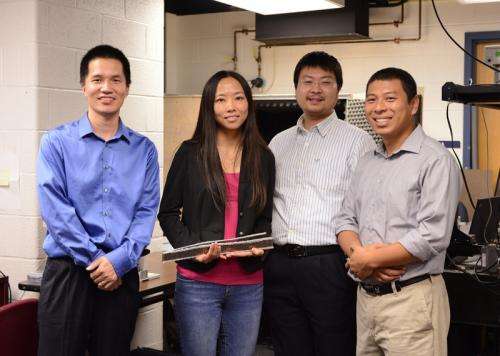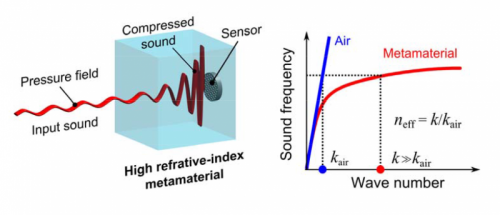Researchers use artificially engineered materials to create breakthrough for sound sensors

University of Maryland (UMD) A. James Clark School of Engineering researchers have developed breakthrough technology to improve sound sensor capabilities through the use of artificially engineered materials.
Sound, or acoustic sensors, play important roles in a wide range of uses. From sonar navigation and detection to medical imaging for cancer and therapies, sensors are an important part of daily life. However, current sensors, like ultrasound for tumor detection or sensors monitoring a bridge's structural health, are limited in their ability to detect weak acoustic signals. These weak signals fall outside of most sensors' minimal detectable range, so extremely small tumors or fine damage in a bridge's foundation may go undetected. This year, sensor limitations also made international news as underwater sonar attempts failed in the deep waters of the Pacific to locate signs of missing Malaysian Airlines Flight 370.
Led by Department of Mechanical Engineering Associate Professor Miao Yu, the UMD researchers are addressing current sensor limitations by developing new uses for artificially engineered materials—metamaterials—to improve acoustic sensing capabilities. Nature Communications published the team's breakthrough research, "Enhanced Acoustic Sensing through Wave Compression and Pressure Amplification in Anisotropic Metamaterials," in their October 15 issue, and it is the first research to uses metamaterials in improving acoustic sensing.
While researchers have explored using acoustic metamaterials for applications like invisible cloaking, sound isolators and acoustic absorbers, Yu's team is the first to show how metamaterials can alter sound waves to improve sensor detection.
The UMD team has created a new sensing platform that uses acoustic metamaterials—artificial materials specifically designed to manipulate sound waves—to enhance acoustic detection. The team created a metamaterials structure that could compress and amplify a sound wave before it reaches the sensor, so the sensor has a better chance of picking up the wave, or signal. In effect, the process 'concentrates' the sound wave into a range the sensor can detect. This new system allows a sensor to pick up weaker, or low volume, signals that previously would have been undetectable to current sensors.

Metamaterial enhanced sound signal detection could advance sensor technologies in many applications, such as acoustic navigation, communication, surveillance, structural health monitoring and medical imaging. For example, improved medical imaging sensors could possibly detect tumors and cancerous growths at an earlier stage, while improved underwater sonar sensors could help locate objects from a greater distance or depth.
Yu's research is part of a three-year National Science Foundation funded project in the Division of Civil, Mechanical and Manufacturing Innovation (CMMI) to investigate acoustic wave control using metamaterials. Her team includes Research Associates Drs. Yongyao Chen, Haijun Liu and Hyungdae Bae, and Undergraduate Research Assistant Michael Reilly.

More information: "Enhanced acoustic sensing through wave compression and pressure amplification in anisotropic metamaterials." Nature Communications 5, Article number: 5247 DOI: 10.1038/ncomms6247
Journal information: Nature Communications
Provided by University of Maryland





















